Development of a Virtual Archive
Ain Dave Kiil
Introduction
The history of Canada's Estonians began in 1899 - 110 years ago - with the arrival of the first Estonian pioneers to Canada's Northwest Territories. Part of this huge, sparsely-populated region became the Province of Alberta in 1905.
Two brothers, Kristjan and Hendrik Kingsep, had left their home in Võrumaa in search of a new life. Within a few years, over sixty of their compatriots joined them and provided the impetus to establish several Estonian settlements. The story of Alberta's Estonians is unique in all of Canada.
The purpose of this paper is to:
- outline the history of the first Estonian settlements in Alberta and later-arriving immigrants,
- describe the development of a major project to collect and preserve the history and cultural heritage of Alberta's Estonian community,
- provide an online demonstration of Alberta's Estonian Heritage website, and
- outline steps to collect, consolidate, preserve and provide access to the archival materials of the Estonian community.
Alberta's Estonians: A historical snapshot
By the start of World War I the so-called 'First Wave' of about 500 Estonian pioneers had settled in Alberta in search of freedom and availability of agricultural land. Sylvan Lake was the first Estonian settlement in the province, but soon most of the contiguous homestead land in the area was taken up by other ethnic groups, preventing the Estonians from establishing a larger community. Some of the early arrivals, especially a group from Saaremaa, applied for homestead land in the Sylvan Lake area and settled there; many others ventured in easterly and westerly directions in search of suitable agricultural land.
Alberta's Estonian Settlements
- Sylvan Lake: 61 Estonians in 1903
- Big Valley: 15 Estonians in 1905
- Stettler: 171 Estonians in 1910
- Medicine Valley: about 160 Estonians in 1916
- Barons: 77 Estonians in 1908
- Foremost/Warner: Nine Estonian homesteads in 1912
- Walsh: 12 Estonian families in 1907
- Peace River: 30 Estonians in 1920s
A small group from the Võru region travelled about 40 km in a westerly direction and found the landscape in the Medicine River Valley to their liking as it reminded them of their homeland. Another group arrived from the Nurmekunde - Tver region in the Russian Empire and travelled in an easterly direction into Prairie Country. After several weeks of travel, they found suitable farmland about 100km east of Sylvan Lake, near the small communities of Stettler and Big Valley.
These two settlements-Medicine Valley and Stettler/Big Valley-were established in 1902 and 1903, respectively, and became sizeable pioneer communities. A third Estonian settlement, Barons, in southern Alberta, was established in 1904 by settlers arriving from South Dakota in the U.S or directly from Crimea. During the next twenty years, smaller groups, families and individual settlers established three additional Estonian communities: Foremost/Warner and Walsh in southern Alberta and Peace River, some 350 km northwest of Edmonton.
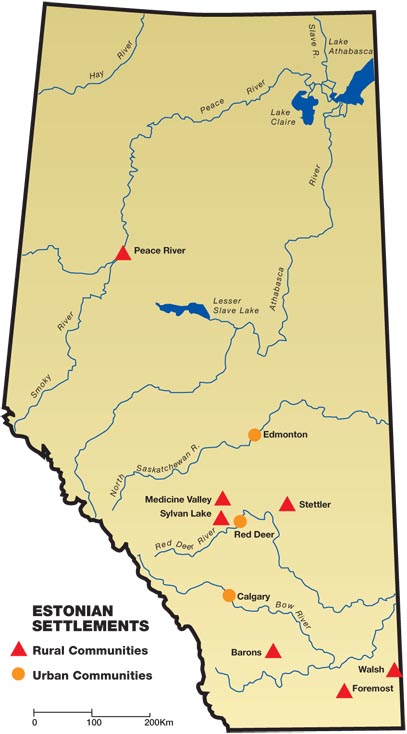
Quarter-sections (160 acres or 64.75 ha), of homestead land were available for $10.00 and, for most settlers, the availability of land and freedom from oppression were the primary magnets attracting Estonians from Estonia, Livonia, and Estonian communities in the Tver, Samara, Simbirsk and Crimea regions of the Russian Empire. The difficult early period of settlement involved clearing land for cabins and houses, and for agriculture.
As the settlers became established, socioeconomic initiatives in the form of societies, traditional festivals and celebrations, and other collaborative activities became common. Medicine River and Stettler/Big Valley soon established societies and clubs. Community halls, a small church, several cemeteries, marketing cooperatives, a variety of social activities like Christmas and midsummer (Jaanipäev) celebrations, bands and sports clubs became integral parts of community life. The Medicine Valley Estonian Society (MVES) in particular produced and preserved minutes of their meetings from inception in 1910 to dissolution in 1984, a span of 74 years! An Estonian agricultural society (Põllumeeste Selts) was established in Stettler in 1909, followed by the opening of the venerable Linda Hall in 1911.
The three largest communities maintained the traditions of their ancestors. Weddings involving pioneer families were common during the first few decades, especially in the Stettler area. In Barons, family get-togethers and social events were popular. Not surprisingly, second and third generation descendants of Estonian pioneers increasingly left the farm to obtain higher education and employment in the cities. Mixed marriages became common.
An additional 100 Estonians, sometimes referred to as the "Second Wave" of settlers, arrived between the two World Wars.
The so-called "Third Wave" of about 500 post-World War II Estonian immigrants arrived in the late 1940s and the 1950s. The majority of these newcomers eventually settled in Calgary and Edmonton, with Medicine Valley also a prime location. They contributed to a revitalization of the province's Estonian community and heritage preservation. Societies were established in both cities.
The Edmonton and Calgary Estonian Societies were established in 1949 and 1950, respectively, and were comprised largely of post-World War II immigrants whereas the pre- World War II societies drew their membership primarily from the local pioneer agricultural settlements in Stettler/Big Valley and Medicine Valley. The societies sponsored Independence Day celebrations, midsummer festivals and Christmas gatherings, including several province-wide events.
By the 1950s about 1,000 Estonians had settled in Alberta. According to the 2001 and the 2006 Canada Census, about 1,900 and 2,100 Albertans, respectively, claimed Estonian roots (Tables 2 and 3).
| Location | Total | Single | Multiple |
|---|---|---|---|
| Calgary | 750 | 115 | 630 |
| Edmonton | 500 | 115 | 390 |
| Red Deer | 110 | 10 | 100 |
| Stettler County | 100 | 15 | 100 |
| Lacombe County | 60 | 10 | 50 |
| Lethbridge | 60 | 30 | 30 |
| St. Albert | 50 | 0 | 35 |
| Canmore | 35 | 15 | 20 |
| Others | 495 | 50 | 460 |
| Totals | 2,160 | 360 | 1,800 |
| Source: Canada Census 2006 | |||
Note: Of the total population of 2,160 17% of Alberta Estonians claimed single ethnicity in the 2006 Canada Census. A Total of 470 of 2,160 Albertans with Estonian ethnicity, or 22% are younger than 15.
| Location | Total | 1st Generation | 2nd Generation | 3rd Generation |
|---|---|---|---|---|
| Calgary | 580 | 75 | 225 | 285 |
| Edmonton | 430 | 110 | 165 | 155 |
| Red Deer | 100 | 15 | 10 | 80 |
| Lethbridge | 45 | 20 | 15 | 15 |
| Others | 535 | 45 | 545 | 340 |
| Totals | 1,690 | 265 | 960 | 875 |
| Source: Canada Census 2006 | ||||
Note 1: In the 2001 Canada Census, 8,720 respondents across Canada claimed Estonian as their mother tongue. A total of 22,085 respondents reported that they had Estonian roots.
Note 2: According to the 1951 Canada Census fewer than 1,000 Albertans claimed Estonian roots.
The history of the Estonian diaspora in the province has been preserved by pioneers and their descendants, and recorded in family histories and local history society publications. In 1965, the Estonian Canadian Historical Commission (ECHC) in Toronto sponsored a major research project to document the history of Alberta's unique Estonian community. Robert Kreem and Helene Johani interviewed many Alberta Estonians to collect historical documents, audio recordings, photos and written accounts of pioneer life. These materials were loaned to the ECHC by Alberta's Estonians and formed the basis for articles later published in "Eestlased Kanadas" (Estonians in Canada, 1975).
During the same period of time, post-World War II immigrant Voldemar Matiisen of Medicine Valley researched and wrote a definitive account entitled the "History of the Medicine Valley Estonian Settlement" (Matiisen, 1975) . The original document is in Estonian but, because of its importance, an English translation is now available. It has been used as a primary source of information for the aforementioned "Estonians in Canada" and "Estonians in Alberta" (Palmer and Palmer 1985) of the University of Calgary. These documents cover the history and culture of Alberta's Estonians from the viewpoints of both Estonian and Canadian researchers.
In 1983, the Tartu Institute's Library and Archives in Toronto received five boxes containing 354 unique Estonian books and files, including a list of titles of the extensive Medicine Valley Estonian Society's (MVES) Library. Some files of the Calgary Estonian Society are also stored there.
In 1984, a major exhibit about Alberta's Estonians opened at the Red Deer Museum and Archives in central Alberta. The exhibit, coordinated by Rita Matiisen of the MVES, ran for many years and informed Albertans about the Estonian presence in the province. She also donated the Society's valuable historical records to the Library and Archives of Canada in Ottawa. The collection has been catalogued and copies of the files are available for a fee. Following a request by the AEHS, the Library and Archives of Canada has agreed to transfer the MVES collection to the Provincial Archives of Alberta.
In 1990, Mati Talvik and an Estonian TV production crew visited Canada and produced a 12-part series entitled "Eestlased Kanadas" (Estonians in Canada), later shown on ETV. Part 2 is a 45-minute DVD about Alberta's Estonian community.
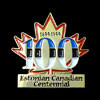 More recently three major celebrations were held in Stettler, Gilby (Medicine Valley) and Barons in 1999, 2001 and 2004, respectively, marking 100 years since the arrival of Estonian pioneers to these settlements. All three centennials drew large crowds of post-WW II immigrants and multi- generational descendants of earlier settlers and stimulated interest in their cultural heritage. Descendants of pioneer families prepared illustrated displays or Family Storyboards and, in some instances, detailed family trees. More recently, one of these family trees shows about 1,750
connections involving numerous Estonian pioneer families in the Province.
More recently three major celebrations were held in Stettler, Gilby (Medicine Valley) and Barons in 1999, 2001 and 2004, respectively, marking 100 years since the arrival of Estonian pioneers to these settlements. All three centennials drew large crowds of post-WW II immigrants and multi- generational descendants of earlier settlers and stimulated interest in their cultural heritage. Descendants of pioneer families prepared illustrated displays or Family Storyboards and, in some instances, detailed family trees. More recently, one of these family trees shows about 1,750
connections involving numerous Estonian pioneer families in the Province.
In the year 2000, Estonian President Lennart Meri visited historic Linda Hall near Stettler and the nearby small Estonian House (Museum), and expressed keen interest in the history of the province's Estonian diaspora while stressing the need to keep our cultural heritage alive.
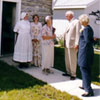 The centennial celebrations and President Meri's visit were highly successful. At the same time, it was increasingly obvious that the Calgary and Edmonton Estonian Societies, with an ageing post-World War II membership, could not maintain effective programs much longer.
The centennial celebrations and President Meri's visit were highly successful. At the same time, it was increasingly obvious that the Calgary and Edmonton Estonian Societies, with an ageing post-World War II membership, could not maintain effective programs much longer.
During a visit by Estonian athletes at the 2001 World Athletics Championships in Edmonton, an article in "Eesti Päevaleht" (Lääne 2001) referred to the need to consider a provincewide organization to more effectively preserve and promote Estonian culture and traditions. By 2003 a consensus was forming around the idea that a province-wide society would best help us achieve this goal.
Discussions and a formative meeting in 2004 led to the formal establishment of the Alberta Estonian Heritage Society (AEHS) in 2005. Membership is made up of mostly multigenerational descendants of pioneers and immigrants from across Alberta, a province with an area nearly 15 times the size of Estonia! Owing to the makeup of the membership, our working language is English. Province-wide, perhaps 20 older post-WWII immigrants are proficient in their mother tongue. It is encouraging to note that Estonian language lessons are still available on a private basis in Calgary.
Twenty years ago, the Edmonton Estonian Society started publishing "AjaKaja", a singlesheet newsletter, covering activities and news of general interest. Initially published in Estonian, then in both English and Estonian, most issues during the last five years have been in English. "Ajakaja" became the official publication of the Alberta Estonian Heritage Society in 2005. Issued twice annually, the 30 to 40-page publication contains articles about Society activities, stories about pioneer families and current members, and news from Estonia.
The AEHS sponsors annual general meetings, major midsummer (Jaanipäev) festivals every two years (2005, 2007 and 2009) and other events of interest. An AEHS website enables members and other Internet users to be introduced to the Society.
Other recent program and activity highlights include a meeting of the Board of Directors in Tallinn in 2007, the so-called Great Estonian Stone Exchange (GESE) in 2008 between relatives to commemorate the link between the first Estonian pioneer family to settle in Alberta and their ancestral home in the Võru area, and participation in recent West Coast Estonian Days in Los Angeles and Seattle along the Pacific coast of North America.
Alberta Estonian Heritage Society's legacy project
Until about three years ago, the collection, preservation and availability of historical material about the province's Estonians was, at best sporadic with little, if any, thought given to the establishment of a permanent archive. Historical materials have been maintained by individual families and local societies, and made available to researchers and the media on an as needed basis. Since the mid-1960s, historical files and photos have also been made available to Library and Archives of Canada and the Estonian Central Archives in Toronto.
 In 2006, the AEHS received an invitation from the organizers of the 2007 West Coast Estonian Days in Los Angeles to make a presentation about Alberta's Estonians. A decision to accept the invitation set in motion a major project for a small society, including the production of a 30-minute documentary film "Alberta's Estonians" and a more or less concurrent development of a digital heritage website.
In 2006, the AEHS received an invitation from the organizers of the 2007 West Coast Estonian Days in Los Angeles to make a presentation about Alberta's Estonians. A decision to accept the invitation set in motion a major project for a small society, including the production of a 30-minute documentary film "Alberta's Estonians" and a more or less concurrent development of a digital heritage website.
The remainder of this presentation will describe and demonstrate the collection, preservation and accessibility of archival material pertaining to the history and cultural heritage of Alberta's Estonians.
Planning for the project got underway in summer of 2006. In the absence of easily accessible information about the province's Estonian pioneers and immigrants, Society members were contacted and asked to review and to make their heritage material available for the DVD and the digital heritage archive.
In response, many textual materials, photographs, audio cassettes, videos and a variety of historical documents were received. The material ranged from publicized accounts of family histories, "AjaKaja" articles, homemade movies, recordings of music, articles from local history society publications and newspapers, to printed and/or digitized photographs.
Early in 2007 a story outline and production timetable were developed for the DVD as the centerpiece of our presentation in Los Angeles in fall of 2007. Photographic images, video footage, oral interviews, music and narration highlighted the storyline tracing the history and culture of the Estonians who made Alberta their home.
The next phase of the memory project involved the production of a website. Its development has proven both challenging and, at the same time, rewarding. Printed and digital materials include literature, audiovisuals and thousands of photographs. Digitizing, formatting, captioning of images, writing of stories, researching, and maintaining contact with contributors of historical information have generated an impressive data base.
In addition to the collection of materials provided by Society members, the project has involved visits to libraries, archives and museums, contacts with and acquisitions of relevant information from the Provincial Archives of Alberta, the National Library and Museum of Estonia, Saaremaa Museum, Estonian Central Archives in Toronto, Tartu Institute in Toronto, the Library and Archives of Canada, and the University of Alberta Library and Archives in Edmonton.
As part of its centennial celebration in 2005, Alberta launched a visionary project AlbertaSource.ca, home of the Alberta Online Encyclopedia. It is a web portal developed by the Heritage Community Foundation (HCF) "to bring Alberta to the world and the world to Alberta." Having explored different approaches to develop the Alberta Estonian heritage project, the AEHS decided to become partners with AlbertaSource.ca to produce an authoritative website entitled Alberta's Estonian Heritage.
The Society assumed responsibility for project coordination, the development of the storyline, the collection and preparation of materials for website production, and research. The HCF looked after the data base design, website production and online maintenance.
The so-called Phase 3 of website production was completed in May 2009. A new section about the role and cultural contributions of post-World War II immigrants, several hundred photographic images, newspaper articles and other published material, digitized copies of "AjaKaja", and enhanced coverage of athletes and musicians, both local and Estonian, expanded the storyline substantially.
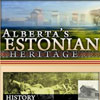 Alberta's Estonian Heritage website contains several hundred pages of illustrated stories, historical documents, over 1100 searchable photographic images with captions, and nearly an hour of audiovisuals. A sitemap (table of contents) and search webpage provides the user with a roadmap to available information on this digital highway.
Alberta's Estonian Heritage website contains several hundred pages of illustrated stories, historical documents, over 1100 searchable photographic images with captions, and nearly an hour of audiovisuals. A sitemap (table of contents) and search webpage provides the user with a roadmap to available information on this digital highway.
The HCF recently transferred the maintenance of the heritage website to the University of Alberta in Edmonton and ceased operations in June, 2009. Our intent is to enhance the heritage website with new materials.
An online demonstration of the AEHS digital archive introduces the major themes, website design, and highlights the history and cultural heritage of Alberta's Estonians in words and pictures.
A digital highway for information and networking
Alberta's Estonian Heritage website tells the story of individuals and families, from pioneers to present-day descendants and immigrants, who have made Alberta their home. The story is told under five main thematic elements:
- History: Introduction of Estonian history with a more detailed look at why Estonians came to Canada, their origins and their journeys.
The section explores the social and political conditions in Estonia before and after the arrival of Estonian pioneers in Alberta. Their origins in Estonia, Livonia and other regions of the Russian Empire, and their emigration patterns and settlements in Alberta are covered. Several major documents provide detailed descriptions of Alberta's Estonian community from initial agricultural settlements to present-day efforts to preserve and promote their cultural heritage. - People: Description of pioneer families and later immigrants, including currently active individuals involved in preserving their Estonian cultural
heritage in an ethnically diverse province.
This section tells the story of the individuals and families who settled in Alberta and who contributed to the development of the province from 1899 through to the first decade of the 21st century. Pioneer families as well as post-World War II immigrants who shaped the growth and development of Alberta are included. - Communities: Coverage of the early agricultural communities as well as Estonian organizations in urban areas.
This section explores the main Estonian settlements - Sylvan Lake, Medicine Valley, Stettler/Big Valley and Barons- established before Alberta became a province in 1905, and the three smaller communities of Walsh, Foremost/Warner and Peace River established between 1907 and 1924. - Cultural Life: This section describes the life and times of Alberta's Estonians and efforts to preserve and promote their culture.
Cultural heritage continues to be highly valued among Alberta Estonians. Arts and crafts, customs and traditions, leisure and recreation, and organizations are the main categories included. A memorable visit by former Estonian President Lennart Meri in 2000 and numerous appearances by Estonian musicians, conductors, choirs and athletes heightened interest in things Estonian and strengthened the commitment to preserve our heritage. - Multimedia Resources: This section provides a searchable digital photographic archive and audiovisual footage from oral interviews. Entire issues or selected articles from "AjaKaja" are included, as are Estonian media clippings.
This journey along the information highway provides us with an opportunity to stop at over a thousand locations to learn about the history and culture of this small but active ethnic community.
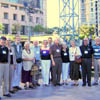 The website provides excellent opportunities for cooperation and networking within and between individuals, organizations and memory institutions. Associated documents, data and images stored on computers can easily be accessed and exchanged to facilitate research, to communicate information on topics of mutual interest, and to preserve materials for use by future generations.
The website provides excellent opportunities for cooperation and networking within and between individuals, organizations and memory institutions. Associated documents, data and images stored on computers can easily be accessed and exchanged to facilitate research, to communicate information on topics of mutual interest, and to preserve materials for use by future generations.
Alberta Estonian Heritage Society Archival Collection
The final phase of this heritage project, now underway, involves the collection and preservation of historical information about the Estonian diaspora in the Province of Alberta. It will include historical records used in the development of the digital archive as well as materials, submitted by members and friends of the Society, but not used in the production of "Alberta's Estonians" DVD and the heritage website.
In September 2009 the Society's Board of Directors established an Archival Committee to solicit archival materials from members and past members, including Estonians who have lived in Alberta but now reside out of province or the country. Qualifying materials include documents, photos, correspondence, diaries, certificates, drawings, casettes and films.
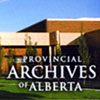 The AEHS has decided to donate its materials to the Provincial Archives of Alberta (PAA) in Edmonton. In the future, donations can be made by the AEHS as well as individuals who want their family records preserved in a safe location for use by their descendants, historians, and other interested individuals and institutions. Individual donations will not be part of the AEHS Collection.
The AEHS has decided to donate its materials to the Provincial Archives of Alberta (PAA) in Edmonton. In the future, donations can be made by the AEHS as well as individuals who want their family records preserved in a safe location for use by their descendants, historians, and other interested individuals and institutions. Individual donations will not be part of the AEHS Collection.
Current plans call for the initial donation to be made by March 2010. The Collection will be described and catalogued and will eventually become accessible onsite at the PAA and online.
We anticipate that relevant collections currently stored in a number of out of province locations, including the Estonian Central Archives and Tartu Institute in Toronto, will become part of the AEHS Collection. The Medicine Valley Estonian Society files are being transferred from the Library and Archives of Canada to the Provincial Archives of Alberta. Several major documents about Alberta's Estonian pioneers, including relevant sections in "Estonians in Canada" (Laaman, 1975; Piirvee, 1975) and the "History of the Medicine Valley Estonian Settlement" (Matiisen, 1975) have been translated from Estonian to English and will be included in an illustrated print version of the "Story of Alberta's Estonians".
Summary and Conclusions
The history of Alberta's Estonians spans 110 years, a period longer than many other Estonian expatriate communities worldwide.
In the absence of a traditional archive for the preservation of historical-cultural information about Alberta's Estonian diaspora, we decided to develop and produce a documentary "Alberta's Estonians" DVD and a dynamic Alberta's Estonian Heritage website. The information is based on thorough research, enthusiastic participation by Alberta's Estonians, and collection of materials from individuals, organizations and institutions in Canada and Estonia. Much of the material has been digitized, and preserved on CDs and DVDs.
The collection, organization and verification of submitted materials and development of descriptions such as captions for images were done by a handful of dedicated AEHS volunteers and HCF staff. Meetings, scanning sessions and progress reports about the DVD and website helped to increase awareness of the project and donation of materials. Given the nature of this memory project, i.e. absence of a central archival collection, the preparation of storylines for the digital archive proceeded in a step-wise fashion as new materials and funds became available.
Going forward, an important challenge to be tackled is the need to preserve all of the historical and cultural heritage information, including original literature, photographic images and audiovisual materials.
Volunteers interested in their heritage know their subject matter and are invaluable for collecting, describing and preserving these materials. Training of volunteers is important, but the availability of professionals and funds, especially for development of digital archives and proper procedures for organizing and preserving collections, is important for accessing archival files and digitized materials. Archives developed and managed by volunteers are often not organized systematically or in a timely manner, with the result that collections may not be widely available.
Most 3rd to 7th generation descendants of Alberta's Estonians do not speak Estonian, yet many have connections with and an interest in their ethnic roots. "Alberta's Estonians" DVD and Alberta's Estonian Heritage website are in English to better inform Alberta's Estonian community and the public-at-large about the history and cultural heritage of the province's Estonians. This approach is consistent with our experience that the preservation and promotion of the Estonian spirit, culture and traditions can, in a specific setting, survive and even thrive with limited use of the mother tongue.
Future work to enhance the heritage project will continue as needed, but the main focus will be on the establishment of a comprehensive Alberta Estonian Heritage Society Collection at the Provincial Archives of Alberta in Edmonton. Almost all materials, including thousands of photographs and many of the printed articles and documents, are already in a digitized format. Publications, documents, photographs, both originals and copies, will be part of the collection. Procedures for donating archival materials are being developed and will be communicated to AEHS members and others with Alberta connections.
With the help of a grant from the Estonian Ministry of Education and Research (Kiil and McClung, 2009), and in collaboration with the Baltic Heritage Network and interested memory institutions, the intent is to preserve and make available the history and cultural heritage of Alberta's Estonians. Professional guidance and contributions will continue to be sought, and a priority will be placed on increased awareness of and accessibility to the Collection.
Acknowledgements:
This AEHS heritage project received financial support from the following organizations:
- National Estonian Foundation of Canada (Eesti Sihtkapital Kanadas), (2006, 2009),
- Government of Alberta (2007),
- Government of Canada (2007), and
- Estonian Ministry of Education and Research (Eesti Vabariigi Haridus- ja Teadusministeerium), (2009).
I am indebted to many members of the Alberta Estonian Heritage Society for their valuable contributions to the heritage project: President Bob Kingsep for his overall leadership, members of the Board, and many members and friends of the Society. Eda McClung and Helgi Leesment deserve special recognition for their many significant contributions to the project since its inception.
References
- Alberta's Estonians: Alberta Estonian Heritage Society, 2007. DVD.
- Alberta's Estonian Heritage. Alberta Online Encyclopedia. University of Alberta, 2009.
- Kiil, Dave, Eda McClung. "AEHS Heritage project receives financial support from Estonian Government" AjaKaja Vol. 30, Summer 2009: 8-9. Print.
- Laaman, Ottomar. "Eestlased Kanadas enne Esimest Maailmasõda." Eestlased Kanadas: Ajalooline Koguteos, Toim. Alfred Kurlents, Richard Antik, Jaan Olvet. Toronto: Kanada Eestlaste Ajaloo Komisjon, 1975. Print.
- Lääne, Tiit. "Eestluse teine sajand Albertas." Eesti Päevaleht 25 August 2001. Print.
- Matiisen, Voldemar. History of the Medicine Valley Estonian Settlement. 1975. Print.
- Palmer, Howard, Tamara Palmer. "Estonians in Alberta." Peoples of Alberta: Portraits of cultural diversity. Saskatoon, Saskatchewan: Western Producer Prairie Books, 1985: 195-213. Print.
- Piirvee, Raimond. "Eestlased Kanadas kahe maailmasõja ajavahemikul." Eestlased Kanadas: Ajalooline Koguteos. Toim. Alfred Kurlents, Richard Antik, Jaan Olvet. Toronto: Kanada Eestlaste Ajaloo Komisjon, 1975.
- Talvik, Mati. "Eestlased Kanadas 2." ETV, 1990. DVD.








